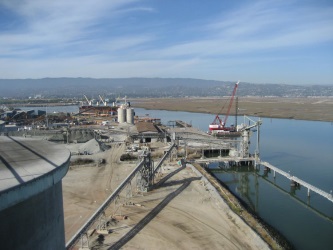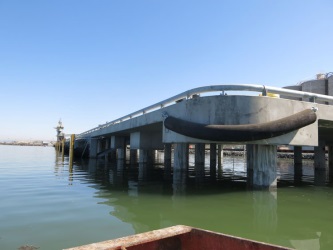
| April 29, 2014 | |
Port Development: Guam, Palm Beach, Redwood City
![]() Print this Article | Send to Colleague
Print this Article | Send to Colleague
A ground breaking ceremony on April 14 marked the start of construction on the largest project of the Port Authority of Guam’s Commercial Port Improvement Program. The U.S. Army Corps of Engineers has given its final approval for dredging the Lake Worth Inlet and areas around the Port of Palm Beach. The Port of Redwood City dedicated its $17 million modernized wharf with a ceremony on April 23.
Guam Breaks Ground for Commercial Port Improvement Project
A ground breaking ceremony on April 14 marked the start of construction on the largest project of the Guam Commercial Port Improvement (GCPI) Program. The launch of the Facility Expansion project, developed by the Port Authority of Guam and the U.S. Maritime Administration (MARAD), initiates the final phase of the $50 million GCPI Program and is scheduled for completion by the third quarter of 2015.
The expansion includes a new 4.6-acre container yard, a 3.7-acre gate complex, new domestic water and fire distribution system with a 270,000 gallon pre-stressed concrete storage tank, a new electrical load center and associated electrical distribution, high mast lighting, stormwater sewer system and outfall, oil water separators and wash rack facility.
The first GCPI project was the CFS Building Modifications Project finished last January. CFS Building upgrades include a secure cargo storage area, new large rollup doors, and new working spaces. The Selected Demolition and Break Bulk Yard Modifications project expanded the Break Bulk Yard to 10 acres. Both projects were on time and on budget.
Palm Beach Dredging Project Gets Final Corps Approval, Now
Moves to Congress
The U.S. Army Corps of Engineers (ACOE) has given its final approval for
dredging the Lake Worth Inlet and areas around the Port of Palm Beach through the
signing of the Chief’s Report by Lt. Gen. Bostick, the Corps’ Commanding
General and Chief of Engineers.
The project calls for increasing the outer channel from 400 to 450 feet, the inner channel width from 300 to 450 feet, and the channel depth from 35 to 39 feet. The estimated cost is $85.6 million, with the port’s share amounting to $35 million and the balance to come from the federal government. The ACOE study found that the investment would have a 2:1 return.
The port’s last dredging project was completed more than 50 years ago. Annual maintenance is needed to clear shoaling. After the project is complete, the maintenance dredging would be needed only every two to three years.
As part of the project, the port will be responsible for paying the entire cost of relocating approximately 425,000 cubic yards of beach grade sand.
The ACOE’s $5 million Study and Environmental Impact Statement was approved by the Environmental Protection Agency, U.S. Fish and Wildlife Service, National Marine Fisheries Service, Florida Department of Environmental Protection and Florida State Historic Preservation Office. It was also approved by the Office of Management and Budget, a non-governmental independent external review team.
With the signing of the Chief’s Report, the project will be added to the Water Resources Development Act for consideration of funding approval by Congress.
"The port, of course, is very pleased with Lt. Gen. Bostick’s approval," said Port Executive Director Manuel Almira, PPM®. "However, we also recognize that is an important step in what will continue to be a long, arduous process. It will still be many years before the project begins."
More information on the dredging project and the findings of the Chief’s report is available at www.PortofPalmBeach.com/acoe.
Redwood City Dedicates $17 Million Wharf
The Port of Redwood City dedicated its $17 million modernized dry bulk cargo handling wharf with a ceremony on April 23 that featured presentations by Congresswoman Jackie Speier (D-CA), Redwood City Mayor Jeff Gee and Port Commission Chair Lorianna Kastrop.
The new wharf replaces a wooden, World War II-era wharf with a concrete structure designed to the latest operational, seismic, and sea level standards and will be capable of accommodating Panamax-size dry bulk carriers. Cargo transfer from the wharf deck will be handled by mobile cranes and large hoppers. Thirty-foot wide concrete ramps connect the wharf to the shore.

New Wharves 1 and 2, showing concrete decking and silo.
Photo/Port of Redwood City
Construction began in September 2012 with the demolition of the old wooden Wharves 1 & 2 and the adjacent warehouse. A 950-foot long seawall designed to meet storm surges and predicted sea level rise has been built along the shore adjacent to the modernized wharf. Additional project improvements include a new 2,100 square-foot longshoreman’s building, upgraded water/electrical utilities, new seismic monitoring equipment, new security fencing and gates, exterior lighting and parking area.
The new wharf is located on the northern end of the Redwood Harbor Ship Channel, between the Cemex cement marine terminal and the Sims Metals scrap iron terminal. The new portion of the wharves is approximately 430 feet long, 60 feet wide, and served by access ramps on its north and south edges. The remainder of the 900-foot long wharf reuses existing monopile dolphins and connects them with new aluminum walkways.

New wharf corner fender.
Photo/Port of Redwood City
The new seawall consists of steel sheet with a top finished elevation of 13 feet at Mean Lower Low water (MLLW). An allowance for an extension of 1 foot in height is constructed to bring the eventual height of wall to an elevation 14 feet MLLW. The existing shoreline protection is augmented with new 12-inch rip rap rock to prevent potential erosion and scour.
The wharf has been sized to accommodate a new conveyor system with the hopper located at the shoreside portion of the new wharf. Other appurtenances include bollards, fenders, potable water, lighting, electric, power, seismic monitoring accelerometers, and allowance for future ship-to-shore power.
The wharf structure was designed with plastic hinges between the top of the pilings and concrete deck to dissipate earthquake energy. Seismic recording equipment has been installed on the new wharf and the shoreline to monitor earthquake impacts. The level of damage occurring to the wharves can then be directly related to the earthquake motions recorded at the facility.
The design team reviewed available estimated sea level rise estimates from the California Climate Action Team and selected an average expected sea level rise over the 50-year life of the structure, which was 18 inches. The design team coastal engineers also modeled the local conditions and determined that an expected 100-year storm surge of approximately six inches could be expected during the life of the structure.
To account for the expected surge and sea level rise, two feet was added to the height of the wharf to result in a wharf height of 16 feet MLLW.
The port consulted with regulatory agencies to mitigate concerns for the wildlife habitat and water quality. The U.S. Army Corps of Engineers and Bay Area Regional Water Quality Control Board had additional requirements that included use of debris barriers during demolition and use of bubble curtains during pile driving. All creosoted piles and timbers were extracted and disposed of at a special disposal facility.
The project was financed by a $10 million 2012 port revenue bond and port capital project reserves.
